Polynomials
Mathematics Class Tenth
What is a Polynomial? NCERT Exercise 2.1 and 2.2
An expression which consists variables and coefficient and non-negative integer components involving operations of addition, subtraction and multiplication only is called POLYNOMIAL.
Example:
, , , 5, etc.
On the other hand , , , , etc. are not polynomials. Because a polynomial cannot have
(i) an exponent with negative sign , such as , , etc.
(ii) no any term in a polynomial can be dividing by a variable, such as
(iii) an exponent with fractional exponent, such as as it is written as
A Polynomial can have constants, variables, and exponents.
Examples of
Constants: etc.
Variables: , etc.
Exponents: , etc.
Degree of Polynomial
If is a polynomial in , the highest power of in is called the DEGREE OF THE POLYNOMIAL .
Linear Polynomial
Let a polynomial .
Variable of this polynomial has power equal to one (1), thus degree of this polynomial is one (1). Or this is called the Polynomial of degree 1.
A polynomial of degree 1 is known as LINEAR POLYNOMIAL also.
Quadratic Polynomial
Let a polynomial .
Variable of this polynomial has highest power equal to 2. Thus, this polynomial, variable of which has highest power equal to 2 is called Polynomial of 2 degree.
A polynomial of 2 degree is known as QUADRATIC POLYNOMIAL also.
Cubic Polynomial
A polynomial of degree 3 is called a CUBIC POLYNOMIAL.
Example:
, , , etc.
The most general form of a cubic polynomial is
where are real numbers and .
Value of Polynomial
If is a polynomial in , and if is any real number, then the value obtained by preplacing by in , is called the value of at , and is denoted by .
Example:
Let a polynomial
By putting , we get
Here, the value of is called the value of polynomial at .
Zeroes of a Polynomial
A real number is said to be a zero of a polynomial , if .
Example:
Let a polynomial
By putting , we get
By putting in the polynomial in example, we get
Since, here and
Thus, and are called the zeros of the quadratic polynomial .
Zeroes of a Linear Polynomial
If is a zero of , then
i.e.
Thus, zero of a LINEAR POLYNOMIAL is equal to
Thus, zero of a LINEAR POLYNOMIAL is related to its coefficients.
The zeroes of a polynomial are precisely the coordinates of the points, where the graph of intersects the axis.
NCERT Exercise 2.1 Solution Class ten Mathematics
Question: 1. The graphs of are given in the figure below, for some polynomials . Find the number of zeros of , in each case.
(i) 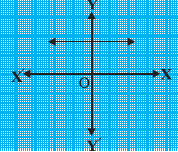
Answer: Since line of graph does not intersect axis, thus number of zeros = 0
(ii) 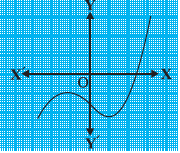
Answer: Since line of graph intersects axis only once, thus number of zeros = 1
(iii) 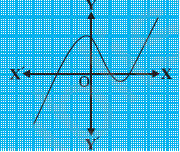
Answer: Since line of graph intersects axis thrice, thus number of zeros = 3
(iv) 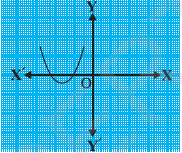
Answer: Since line of graph intersects axis twice, thus number of zeros = 2
(v) 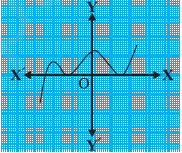
Answer: Since line of graph intersects axis three times, thus number of zeros = 3
(vi) 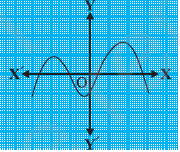
Answer: Since line of graph intersects axis four times, thus number of zeros = 4
Relationship between Zeroes and Coefficients of a Polynomial
If and are the zeroes of the quadratic polynomial , where, then and are the factors of .
Therefore,
, where is constant.
Now, by comparing the coefficients of and constant terms on both sides, we get
-------(i)
----------(ii)
------(iii)
Now,
∵
After replacing the value of from equation (i) we get
-------(iv)
Now,
∵
After replacing the value of from equation (i) we get
---------(v)
Thus, sum of zeroes
And Product of zeroes
NCERT Exercise 2.2 SolutionClass ten Mathematics
Question: 1. Find the zeroes of the following quadratic polynomials and verify the relationship between the zeroes and the coefficients.
(i)
Solution:
Given,
After expanding middle term , we get
[∵ ]
Now, after taking as common, we get
Thus, the value of is zero, when or
Thus,
When
And, when
Therefore,
The zeroes of are 4 and . Answer
Verification of relationship between zeroes and coefficients.
Now, Sum of zeroes
And Product of zeroes
(ii)
Solution:
Given,
[∵ ]
Thus, value of is equal to zero (0), when
Therefore, when,
Thus, the zeroes of are and
Verification:
Sum of zeroes
Product of zeroes
(iii)
Solution:
Given,
After expanding middle term we get
[∵ ]
After taking as common
Thus, value of is equal to zero (0), when or
Thus, when,
And, when,
Thus, zeroes of are and
Verification:
Now,
Sum of zeroes
And, product of zeroes
(iv)
Solution:
Given,
Thus, the value of is zero when, or
Thus, when,
And, when
Therefore, the zeroes of are and
Verification:
Now, Sum of zeroes
And, product of zeroes
(v)
Solution:
Given,
[∵ ]
Thus, the value of is equal to zero, when or
Therefore, when
And when,
Thus, zeroes of are and
Verification:
Now, sum of zeroes
And, product of zeroes
(vi)
Solution:
Given,
By expanding middle term , we get
After taking as common, we get
Thus, the value of is zero when or
Thus, when,
Therefore,
And when,
Therefore,
Therefore, zeroes of are and
Verification:
Sum of zeroes
And, product of zeroes,
Question: 2. Find a quadratic polynomial each with the given numbers as the sum and product of its zeroes respectively.
(i)
Solution:
Given, Sum and product of zeroes of polynomial are and respectively.
Let, the polynomial be ------(i)
And its zeroes are and
Thus, according to question,
Thus, and
Therefore, and
Thus, after substituting the values of and in equation (i), we get
Therefore, the quadratic polynomial for the given values, is Answer
(ii)
Solution:
Given, the sum and product of the quadratic polynomial are , and
Let, the polynomial be ------(i)
And its zeroes are and
Thus, according to question,
Product of zeroes
Therefore, and
Sum of zeroes
[∵ ]
Thus, and
After substituting the values of and in equation (i), we get
Therefore, the quadratic polynomial for the given values, is Answer
(iii)
Solution:
Given, the sum and product of the quadratic polynomial are , and
Let, the polynomial be ------(i)
And its zeroes are and
Thus, according to question,
Sum of zeroes
And product of zeroes
Thus, and
After substituting the values of and in equation (i), we get
Therefore, the quadratic polynomial for the given values, is Answer
(iv)
Solution:
Given, the sum and product of the quadratic polynomial are , and
Let, the polynomial be ------(i)
And its zeroes are and
Thus, according to question,
Sum of zeroes
And, product of zeroes
Thus, and
After substituting the values of and in equation (i), we get
Therefore, the quadratic polynomial for the given values, is Answer.
(v)
Solution:
Given, the sum and product of the quadratic polynomial are , and
Let, the polynomial be ------(i)
And its zeroes are and
Thus, according to question,
Sum of zeroes
And Product of zeroes,
Thus, and
After substituting the values of and in equation (i), we get
Therefore, the quadratic polynomial for the given values, is Answer.
(vi)
Solution:
Given, the sum and product of the quadratic polynomial are , and
Let, the polynomial be ------(i)
And its zeroes are and
Thus, according to question,
Sum of zeroes
And product of zeroes,
Thus, and
After substituting the values of and in equation (i), we get
Therefore, the quadratic polynomial for the given values, is Answer.
